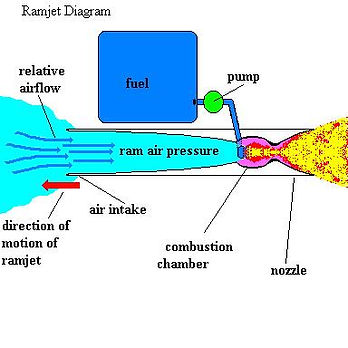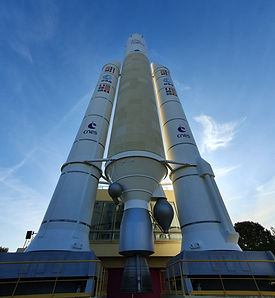
Components of a Rocket
Any conventional rocket has four key parts, or components, that are essential to its flight. These four components are the rocket's structure, the payload, the guidance system and the propulsion system. Each of the components will be individually discussed below. All the parts of the rocket have very specialized functions that aid the rocket in a different manner. While there maybe be some smaller, additional components in some rockets for other specialized reasons, these four components are common in all space rockets.

01
Rocket Structure
The rocket's structure is the outer body, or shell of the rocket. The structural system of the rocket is made up of several different elements such as the cylindrical body, the nose cone, control fins etc. The main function of the rocket's structural system is to protect the internal components of the rocket, to withstand the pressure of the forces afflicted on the rocket and to reduce the amount of aerodynamic drag on the rocket to ensure a smooth and easy flight.
The effectivity of a rocket structure is determined by 3 parameters; strength, weight and design. The rocket structure is required to be strong because the force and pressure applied to it during liftoff is very strenuous. Some weaker metals may not be able to withstand the pressure, and they may melt or dent during flight, making it essential to have a very strong metal shell. The rocket structure is also required to be light weight due to liftoff mass ratios. Some metals may be very strong and capable of withstand large amount of pressure, but they may also be very heavy, making it too difficult for the rocket to lift off the ground. Therefore, to reduce the usage of fuel and to make it easier for the rocket to liftoff, often engineers choose lightweight materials for the outer shell of the rocket. For above reasons, most rockets use either aerospace grade aluminium or titanium, because both metals are strong and light weight.
The final parameter, design, is mainly the shape of the rocket. This parameter is the most important out of the three, and is the most impactful on the rocket flight performance. This is because the design of the rocket has to be very aerodynamic for it to be able to counteract the intense amounts of drag it will face. That is why the structural design is very important, because it can help reduce the amount of force counteracting rocket flight and it can allow the rocket to use up less fuel. Also, the design of a rocket must also take into account the process of staging. Rocket staging is essentially when parts of a rocket are dropped off when their purpose has been completed. This is due to the fact that most of the rocket's weight is made up of the propellants. However, once the propellant has been used, and the tank is empty, the rocket would just be carrying the extra weight of the tank and the body around it. For this reason, engineers design the body in such a way that parts of it break off when the tank they contain is empty, so that the rocket can shed the extra weight and attain a higher velocity with the next engine.
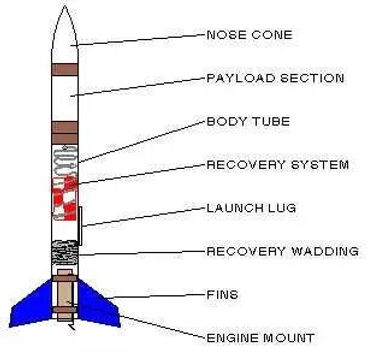

02
The Payload
The payload system of the rocket varies depending on the purpose of the rocket. The payload is essential the main purpose or object of the rocket. Usually this is the thing that has to be delivered through the flight of the rocket. The payload, however, is usually placed on the topmost section of the rocket because of rocket staging. Since it is mostly the bottom parts of a rocket that break apart in staging, the payload is placed in the nose cone at the top, to ensure extra that it is properly protected and that it continues to get lifted by the engines.
There are several different types of payloads that a rocket can contain, each that is unique to its purpose. Fireworks are some of the most common forms of rockets that can be found. Fireworks explode due to the gunpowder they contain, which, in this situation, makes the gunpowder the payload of the fireworks rocket. Missiles are also considered to be a type of rocket, with the main purpose being to explode and destroy things. A missile's payload is its warhead, which is the section that holds the explosive or toxic material. Some forms of explosive can be nuclear or chemical, both of which cause intense shockwaves and exothermic reactions.
Space rockets usually contain different types of payloads, as they are not meant to explode. Most rockets that go into space contain artificial satellites, objects which have intentionally placed into Earth's orbit. Satellites are the most versatile form of payload and have been used for communication, weather monitoring, spying, GPS etc.
However, the most important payload for space rockets is one that contains a human being. These rocket payloads are classified as 'man-rated', meaning that they are capable of safely holding a human. The earliest 'man-rated' rocket payloads were created in the 1960's by the US and the USSR during the Space Race. The most famous 'man-rated' rocket of all time is the Saturn V rocket, created by America's NASA, which was the type of rocket that carried Neil Armstrong and his team to the Moon. Following that rocket, a new model, called the Space Shuttle rockets were created. The Space Shuttle is a unique type of rocket because the payload, which is the shuttle itself, isn't on the topmost section of the rocket, but is rather attached to the side of a large booster. These boosters follow parallel staging, rather than regular staging, which means that the individual boosters detach from the sides rather than from below the payload. The Space Shuttle program was recently discontinued, but was known as one of the most successful 'man-rated' rockets ever.



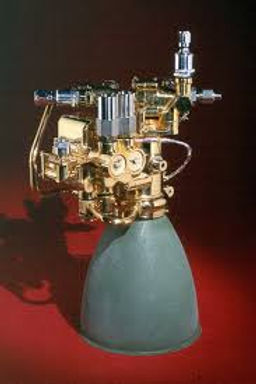
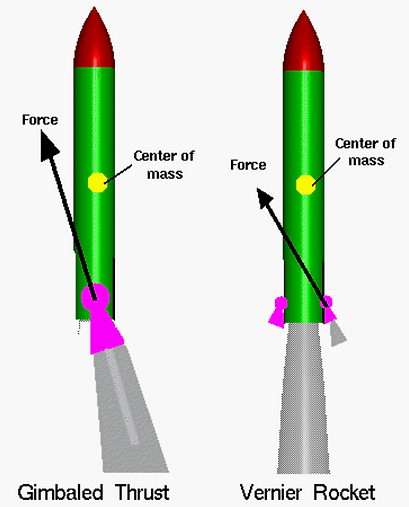
03
Guidance System
The guidance system of the rocket is essentially the brain of the rocket. The guidance system includes communication equipment, complex sensors, radars and computers that help to track and control the motion of the rocket. The main purpose of the guidance system is to make sure that the rocket is following the correct path in space and to support the rocket in a manuever if required.
A rockets direction of motion is highly dependent on the center of gravity and torque of the rocket. The torque is basically the rotation of an object about its center of gravity. There can be changes in the in the torque of a rocket depending on the external forces that affect the flight of the rocket. For this reason, guidance systems were created, so that ground engineers can have some control over the torque of the rocket. Essentially, all common guidance systems will help produce a torque which will rotate the rocket about the center of gravity and toward the correct direction in motion.
There are two commonly used forms of guidance on rockets. The first and earliest guidance system was known as the Vernier Thruster. The Vernier Thruster is a small, low power booster that is attached to the side of a rocket's frame. The Vernier thrusters are activated only when they are necessary, and most of them use fuel from the rocket's main fuel tank to create small boosts at an angle to the rocket's body. These small boosts produce a torque which can help rotate the rocket in the required direction. Most Vernier thrusters are controlled by ground engineers who keep track of the rocket's path.
The second and newest guidance mechanism is the gimbal rocket nozzle. Again, this system is also controlled by the ground engineers who control the path of the rocket. The gimbal nozzle is a regular rocket nozzle, or booster, that can be swiveled from side to side. This swiveling can help to produce a torque in the motion of a rocket, and can help redirect the rocket into its path. Gimbal nozzles are used in almost all new rockets as it is currently the most effective guidance system that can be used.
04
Propulsion System
The propulsion system in a rocket has only one purpose, to produce thrust. The propulsion system includes any element in a rocket that is part of the engine, which could be the propellant tanks, pumps, oxidizers, the nozzle etc. While most rockets have different engines that use various fuels, all rockets follow Newton's Third Law of Motion when producing thrust. Newton's Third Law states that every action has an equal and opposite reaction. In a rocket's case, the working fluid is being accelerated out of the system, which, in turn, produces a force which accelerates the rocket forward. Any rocket's working fluid is the hot exhaust that is being released by the rocket nozzle. Another similarity for all rockets is that they all use a mixture of a fuel and an oxidizer as their propellant. This is because a mixture of these two produces a lot of heat and pressure, which creates a strong working fluid, and in turn, produces a lot of thrust, as is explained in Newton's Third Law of Motion. Even with this similarity, rocket engines are classified under two main categories, solid propellant engines and liquid propellant engines.
A solid propellant engine is a rocket engine that has a fuel in the form of a solid. Usually, in this type of engine, the propellants are mixed together and packed into a solid cylindrical shape. As the rocket is ready for take off, the solid fuel is ignited with a flame and the combustion begins, producing a thrust by ejecting hot exhaust through the nozzle. While it is true that solid propellants are easier to handle and are safer than liquid propellants, solid propellants have a key disadvantage that they need to be completely combusted. A solid propellant's combustion cannot be stopped midway, and the solid propellant must be completely combusted for it to stop. This can cause issues when trying to control the path and motion of a rocket.
Liquid propellant engines, on the other hand, are a lot easier to control, although they are heavier and more complex. A liquid propellant engine, essentially, has a fuel tank and an oxidizer tank with pumps and pipes that lead the two into a combustion chamber. This combustion chamber leads directly to the nozzle, where the working fluid is released to produce thrust. To start the combustion, both the fuel and the oxidizer need to be pumped into the combustion chamber, through the pipes, where they will immediately be ignited. Once ignited, the fuel and oxidizer will be continually pumped into the engine to continue the combustion. However, if required, the flow of fuel and oxidizer can be reduced or even stopped, which allows the engineers a certain amount of control over the amount of thrust produced by the engine. For this reason, liquid propellant engines are more popular than solid engines in modern rocketry.


